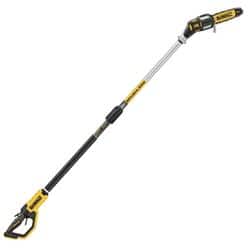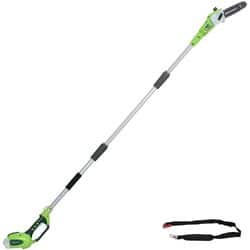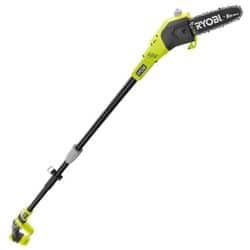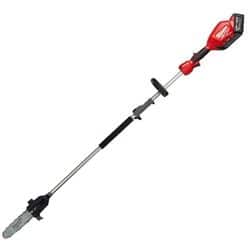The Best Cordless Pole Saws — Buyers Guide, Review, and Comparison
Cordless Pole Saw Comparison Table
| IMAGE | PRODUCT | DETAILS | ||
|---|---|---|---|---|
|
Top Pick 
|
Top Pick
|
DeWalt DCPS620B
|
Features
|
Check Price at Amazon Review DeWalt DCPS620B Review DeWalt DCPS620B Review |
|
Best 40v Cordless Pole Saw 
|
Best 40v Cordless Pole Saw
|
Greenworks 20302
|
Features
|
Check Price at Amazon Greenworks 20302 Review Greenworks 20302 Review |
|
Best Tight Space Battery Pole Saw 
|
Best Tight Space Battery Pole Saw
|
Ryobi ONE+ P4360BTL
|
Features
|
Check Price at Amazon Ryobi ONE+ P4360BTL Review Ryobi ONE+ P4360BTL Review |
|
Best Pole Saw Battery Included 
|
Best Pole Saw Battery Included
|
Milwaukee M18 Fuel 2825-21PS
|
Features
|
Check Price at Amazon Milwaukee M18 Fuel 2825-21PS Review Milwaukee M18 Fuel 2825-21PS Review |
Best Cordless Pole Saws Buying Guide
Effortlessly portable and reducing the risks of electrical cord tripping, strangulation, or cable severing, these powerful units are ideal for addressing bushes, shrubs, and trees without having to scale a shaky ladder.
But, with an absolute plethora of models on the market addressing different needs, requirements, and budgets — it’s crucial that you select a unit equal to your arboreal artistry.
When choosing your perfect tree trimmer cordless unit, consider:
- Length of the pole.
- mAh of the battery.
- Brushless or brushed motor.
- Battery voltage.
- Length of the chain.
- Incorporated auto-oiling system.
- See-through oil reservoir.
- Arrives with or without a pole saw battery and charger.
- The weight of the battery powered pole chainsaw.
What Is a Pole Chainsaw Battery Powered?
For an in-depth explanation of pole saws in general — including their uses, engineering, and areas of application — check out my Complete Guide to Pole Saws. However, for a brief discussion of battery powered pole chain saws, here it is.
These versatile tools permit you to address high-level tree branches and arms without the need for ladders or scaffolding — their lengthy shafts allowing you to reach these challenging areas while remaining safely on the ground.
But, what separates a battery operated pole saw from its corded cousins, is that it’s driven by a lithium-ion cell instead of a mains lead.
Why Choose a Battery Operated Limb Saw Over a Corded?
If you have children, do you have a favorite? Of course you do, even if you pretend that you don’t.
It could be that you prefer Jimmy over Jenny, because he’s already interested in DIY and she’s simply content playing with her dolls. Or, maybe you severely dislike Jimmy, as he would rather paint with acrylics or something equally weird instead of wielding a mighty rotary hammer drill. Your wife/partner may think the total opposite.
It’s horses for courses. And the same goes for battery pole chain saw machines over their mains-lead driven siblings.
Sure, corded models have some advantages against cordless tree saw models. They typically offer greater brawn, don’t have the inherent risk of battery failure, are usually lighter weight, and are often cheaper than cordless electric pole saw units.
However, there are a plethora of advantages of choosing a battery pole chainsaw instead of a 120-volt lopper, including:
- Greater portability.
- No risk of mains-lead tripping or strangulation.
- Requires no access to a power socket.
- Doesn’t necessitate lengthy and cumbersome extension cables.
- Can be used with pre-owned lithium cells from other tools.*
*from the same manufacturer.
How to Choose the Best Cordless Electric Pole Saw
To ensure you select the perfect machine to suit your preferences and the demands of your projects — use my Cordless Pole Saw Guide below. Here’s what to scrutinize in your cordless electric tree trimmer.
Pole Length
Just like Olympic long-jumping, tape measuring, and getting down and dirty in the bedroom — length is crucial.
The advantage of pole saws over their standard chainsaw counterparts is that they can reach high-level areas without the need for scaffold or ladders. Naturally, the longer the pole, the more access you have to elevated branches.
However, bear in mind that the longer the shaft, the more unwieldy the battery powered pole saw will become. The further the motorhead from the pivoting point (i.e. your hands), the greater the weight — leading to the increased risk of arm and grip fatigue.
Personally, I wouldn’t opt for a cordless pole pruner that extends beyond ten feet. The DeWalt DCPS620B exemplifies this maximum length, whereas models such as the Milwaukee M18 Fuel 2825-21PS measure only seven feet.
Battery Voltage and Longevity
As mentioned earlier in this battery operated pole saw round-up, one of the few downsides of lithium-ion models over their corded siblings is that they deliver slightly less grunt.
In order to mitigate this downfall, especially if you’re tackling seriously thick or wet timber, go for the highest voltage machine possible. Typically, more volts equal greater brawn — although strictly speaking, this can be offset by the gearing. For example, the 40-volt Greenworks 20302 offers more hardcore output than the 18-volt Ryobi ONE+ P4360BTL battery tree pruner.
Additionally, check out the mAh (milliampere/hour) rating of the power cell — a metric that indicates the longevity of the battery life from a single charge. The higher the mAh, the longer you can crack on with your project without replacing the cell or recharging. Look for machines with an 8.0 mAh or higher.
Brushed or Brushless Motor
DC motors, i.e., those that run off a lithium-ion cell, as with cordless tree pruner units, arrive in two formats — brushed and brushless. The former, as the name suggests, has brushes that make contact with the commutator — delivering current and allowing the rotor to revolve. Brushless examples, conversely, use no brushes — and instead rely on electromagnetic coils and rotating permanent magnets.
Confused? Don’t worry, to make these mechanical theories easy to understand, I’ve put together an Idiot’s Guide to Brushed and Brushless Motors. However, if you don’t have time to read through my explanatory 101, here’s the key — brushless motors are more efficient.
As they’re lacking in brushes, they experience less energy wastage through heat and friction than their brushed counterparts. This is important when selecting your cordless tree saw — such as the DeWalt DCPS620B — as it impacts on the battery life.
Due to higher efficiency, brushed motors experience longer battery life from a single charge — allowing you to crack on with your project with fewer interruptions. That said, bear in mind that the more complicated engineering in brushless models does make them somewhat harder on your pocket than those without.
For corded non-battery limb saw machines, it’s less of a concern. Sure, there will be more draw on your mains supply, but the amount is negligible to impact the running cost of the tool.
Chain Length
Just as with the size of your battery operated tree pruner machine’s shaft, length is crucial for the chain — determining the maximum cut diameter of the unit. These range from a small six inches to the common eight-inch format, through to the hardcore ten-inch size — as with the Milwaukee M18 Fuel 2825-21PS.
Theoretically, the cutting diameter is slightly less than half the chain length. This is because the links circumnavigate the guide bar — hence halving the attacking face. So, an eight-inch battery tree saw could, in principle, lop a four-inch-wide branch in one pass.
The reason that the chains of battery operated pole chain saws max out at ten inches is due to practicality. The longer the cutting links and guard, the more weighty the unit. There’s no way the Average Joe could wield a standard 18-inch chainsaw on the end of a pole — unless they had the strength of Hafþór Júlíus Björnsson and an expansive titanium shaft.
Auto-Oiling System
Personally, I’d steer clear of any cordless pole trimmer that doesn’t feature an auto-oiling system — unless you enjoy increasing your workload for no real reason.
Just as in the bedroom, lubrication is crucial. In battery pole pruner machines, oiling up the chain increases its lifespan by preventing corrosion, guarding against blockages, and shielding from kickback. Additionally, it allows you to plow through dense materials more effortlessly, and, because loads on the power unit are reduced — increases the life of the brushed or brushless motor.
You could purchase a standard budget-priced manual oiler rechargeable pole saw, but this will hamper your projects — meaning you have to stop work every five minutes (literally) to lubricate the chain.
Preferably, opt for an auto-oiling cordless limb saw, like the Ryobi ONE+ P4360BTL. This intelligent system automatically adds oil from the in-built reservoir during operation — thus dramatically cutting back on downtime. That said, you still need to manually fill the oil tank at the start of the job, it’s not freakin’ magic.
Transparent/Translucent Oil Tank
Related to your battery powered tree pruner unit’s auto-oiling system is the above-mentioned reservoir. Although not crucial, if you like making your DIY or trade life as straightforward as possible — go for a cordless branch saw with a transparent or translucent oil tank, such as the Greenworks 20302.
This permits you to effortlessly check the reservoir lubrication levels without having to dip the tank or just make an educated guess. Some cordless pole chain saw units just feature a see-thru window, as opposed to an entirely transparent tank — if that’s the case, ensure it’s sufficiently large to gauge levels.
Tool Only
Malcolm S. Forbes, the founder of Forbes Magazine and a man with an incorrigibly extravagant lifestyle said, the difference between men and boys is the price of their toys.
To be fair, he was talking about his propensity to purchase yachts, airplanes, and Fabergé eggs. Although, the principle still holds true for us DIYers and trade contractors.
Our power tools are our toys. Instead of whipping out our Hornby train sets or He-Man action figures at the weekend, we dive into our garage toy box and pull out a drill or heat gun.
However, do you recall excitedly unboxing your Space 3000 Laser Gun on Christmas morning — only to discover that it required 4 x AAA batteries, and these were unsurprisingly, not included?
Sure you do. Well, if you’re not careful, you could suffer a similar trauma when opening your shiny new battery powered limb cutter. Many of these machines arrive as tool-only — that is without a lithium-ion cell or charger. Thus meaning that without an additional purchase — or a store of cells already in your workshop — you will be unable to immediately get on with serious lopping.
Furthermore, it’s not just the disappointment. As making your rechargeable tree saw operable means spending your hard-earned dollars on batteries and chargers, it can affect the overall cost of your machine. Hence, when comparing the best battery pruning saw machines — ensure you’re comparing like with like, either including cells and power packs or without.
If you want a complete all-in-one package that permits you to attack your trees straight-outta-the-box, go for a lithium pole saw such as the Milwaukee M18 Fuel 2825-21PS that includes everything you need.
Weight
Ok, it may sound obvious, but the heavier your battery operated pole chain saw, the more difficult it is to wield.
Don’t be macho about it. Ohhh, I’m a big guy, I work out, I can handle it, I press 250 pounds every day. Sure you do Schwarzenegger, but you’re not hanging those 250 pounds on an eight-foot pole and waving it above your head for an hour. Hold a two-pound weight, outstretch your arm, and see how long you can maintain that position.
Units range from around eight pounds, as with the DeWalt DCPS620B, though to 14 pounds, exemplified by the Ryobi ONE+ P4360BTL. The greater the mass, the more likely the unit is to induce hand and arm fatigue. This is a crucial concern if your jobs involve extensive time periods operating your cordless tree pruning saw.
When comparing weights of the best cordless tree trimmer machines — investigate whether the manufacturer’s specifications detail the mass as tool only, or pole saw with battery. This is crucial, as lithium cells can weigh anywhere from 1.5-2.5 pounds — in some cases, as much as 25 percent of the battery pole pruner itself.
Conclusion — The Best Battery Cordless Pole Saw
The best battery pole saw machines deliver consummate operational freedom for the keen gardener, landscaper, and trade arborist.
Without the mains tethering of corded models, battery powered pole pruner units allow you to chop, lop, and cut away from power outlets, eliminate the need for lengthy extension leads, and shield against the risks of hazardous cords. And, ideal for addressing high-level branches without scaffold or ladders, they offer a low-effort and safer method of tidying up timber.
When selecting your consummate best cordless pole chainsaw, consider its battery voltage and mAh, the length of the shaft, and the size of the chain. Additionally, scrutinize whether the battery powered limb trimmer features a brushed or brushless motor, auto-oiling system, and if it arrives with a lithium cell and charger.
Sure, they’re not going to suit all users. Some DIYers may prefer the convenience of corded machines, meaning no downtime to exchange batteries or recharge cells. And, contractors attacking seriously hard or wet timbers may prefer the greater grunt offered by mains-lead driven models.
But for both casual and trade users who demand portability, freedom, and convenience in pruning and lopping — I recommend checking out our cordless pole saws top picks above.
Battery Powered Pole Tree Trimmer FAQs
Q: What Is the Best Cordless Pole Saw?
With its high-efficiency brushless motor, a remarkable 10-foot shaft length, and offering 96 cuts per charge — in my opinion, the best battery operated pole saw is the 20-volt DeWalt DCPS620B.
Q: Are Battery Powered Pole Saws Any Good?
Yes. Driven by lithium-ion cells that offer impressive grunt and long-running times from a single charge, battery operated limb trimmer machines provide greater operational freedom than their corded siblings.
Q: What Is the Longest Cordless Pole Saw According to Battery Powered Pole Saw Reviews?
Incorporating a remarkably lengthy shaft measuring ten feet, the DeWalt DCPS620B is possibly the longest battery pole saw, as demonstrated by a multitude of cordless pole saw reviews.
Q: What Makes the Best Battery Powered Pole Saw?
When checking out the best cordless pole saws, I recommend looking for the following features to deliver the greatest user enjoyment and project success:
- A brushless pole saw for energy efficiency.
- High mAh cell to increase the running time.
- A pole saw electric cordless machine with a long shaft.
- Auto oiling to prevent downtime.
- A lightweight battery power tree trimmer to reduce fatigue.
- Positive battery pole saw reviews.
Q: Cordless Pole Saws for Sale — What’s the Best?
In my opinion, boasting a low-energy wastage brushless motor, delivering 96 cuts from a single charge, and with a 10-foot pole length — the best pole saw battery operated is the 20-volt DeWalt DCPS620B.
Q: What Is the Best Commercial Battery Pole Saw?
Boasting a rapid 4600 rpm speed, massive 10-inch chain, and incorporating the respected and long-lasting M18 lithium cell, I suggest the best trade-grade battery powered pole pruner is the Milwaukee M18 Fuel 2825-21PS.
Furthermore, unlike many cordless polesaw machines, the 2825-21PS is a cordless pole saw with battery and charger — meaning you can operate the unit straight from the box, without having to make additional purchases.
Q: Cordless Pole Chainsaw Vs Mains-Lead No Battery Pole Saw?
A cordless battery pole saw has numerous advantages over its non-battery powered pole saw siblings, including:
- Greater portability of pole saw cordless machines.
- No mains lead tripping risks
- No need for a power socket or extension cables.
Q: How Long Does a Cordless Polesaw Battery Last?
If you’re looking at the overall lifespan of a lithium-ion cell, they typically last around three years before they begin to rapidly lose charge or fail completely.
Should you be wondering how many minutes of use you receive from a single charge, this can be more difficult to ascertain — as it depends on numerous factors including the voltage and maH of the cell, the density of the timber being addressed, and the thickness of the branches.
The best method of scrutinizing battery life when reading cordless pole chainsaw reviews is to examine the number of cuts from a sole recharge — typically between 50 and 150, depending on the machine.
